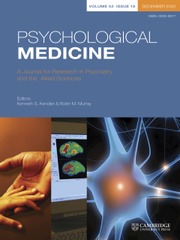Article contents
The association of adverse childhood experiences with long-term outcomes of psychosis: a 21-year prospective cohort study after a first episode of psychosis
Published online by Cambridge University Press: 30 May 2024
Abstract
Evidence suggests a possible relationship between exposure to childhood adversity (CA) and functional impairment in psychosis. However, the impact of CA on long-term outcomes of psychotic disorders remains poorly understood.
Two hundred and forty-three patients were assessed at their first episode of psychosis for CA and re-assessed after a mean of 21 years of follow-up for several outcome domains, including symptoms, functioning, quality of life, cognitive performance, neurological dysfunction, and comorbidity. The unique predictive ability of CA exposure for outcomes was examined using linear regression analysis controlling for relevant confounders, including socioeconomic status, family risk of schizophrenia, and obstetric complications.
There were 54% of the patients with a documented history of CA at mild or higher levels. CA experiences were more prevalent and severe in schizophrenia than in other psychotic disorders (p < 0.001). Large to very large effect sizes were observed for CA predicting most role functioning variables and negative symptoms (ΔR2 between 0.105 and 0.181). Moderate effect sizes were observed for positive symptoms, personal functioning, impaired social cognition, impaired immediate verbal learning, poor global cognition, internalized stigma, poor personal recovery, and drug abuse severity (ΔR2 between 0.040 and 0.066). A dose–response relationship was observed between levels of CA and severity of outcome domains.
Our results suggest a strong and widespread link between early adversity exposure and outcomes of psychotic disorders. Awareness of the serious long-term consequences of CA should encourage better identification of those at risk and the development of effective interventions.
- Type
- Original Article
- Information
- Copyright
- Copyright © The Author(s), 2024. Published by Cambridge University Press
Footnotes
SEGPEPs group: A. Ballesterosa, L. Fañanásb,c, G. Gil-Berrozped,e, R. Hernándezf, R. Lorented, S. Papiolg,h, M. Ribeirod,e, A. Roseroi and M. Zandiod,e
aRed de Salud Mental de Álava, Vitoria-Gasteiz, Spain; bDepartment of Evolutionary Biology, Ecology and Environmental Sciences, Faculty of Biology, University of Barcelona, Biomedicine Institute of the University of Barcelona (IBUB), Barcelona, Spain; cNetwork Centre for Biomedical Research in Mental Health (CIBER of Mental Health, CIBERSAM), Spain; dInstituto de Investigación Sanitaria de Navarra (IdiSNA), Pamplona, Spain; eDepartment of Psychiatry, Complejo Hospitalario de Navarra, Pamplona, Spain; fCSMIJ Ciutat Vella. Consorci Parc de Salut Mar, Barcelona, Spain; gInstitute of Psychiatric Phenomics and Genomics (IPPG), University Hospital, LMU Munich, Munich, 80336, Germany; hDepartment of Psychiatry and Psychotherapy, University Hospital, LMU Munich, Munich, 80336, Germany and iMental Health Department, Servicio Navarro de Salud, Pamplona, Spain
References
- 1
- Cited by



